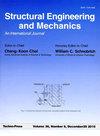1:5缩小比例的五层砌体钢筋混凝土框架结构振动台试验
IF 3
4区 工程技术
Q2 ENGINEERING, CIVIL
引用次数: 0
摘要
本文介绍了一种对五层砌体混凝土框架模型进行1:5缩比振动台试验。采用多级模拟地震运动作为输入,使模型结构从弹性状态变形为近倒塌状态。总结了各阶段各层的动力特性、加速度响应、位移响应、损伤状态、耗能行为和刚度退化情况。试验结果表明:在轻微震动作用下,砌体-框架界面出现裂缝,导致砌体与框架分离;但其面内承载能力保持不变。此外,填充物能够抵抗罕见的地震,而不会造成结构的不稳定或倒塌。因此,在结构抗震设计中将砌体填充物作为结构单元考虑是合理的。层间位移比为1/400可作为控制框架结构开裂的性能准则,层间位移比为1/100可作为框架结构峰值承载力的性能准则。试验结果可为既有建筑的抗震评价提供参考,也可为新建建筑的抗震设计提供参考。本文章由计算机程序翻译,如有差异,请以英文原文为准。
Shake-table testing of a 1:5 reduced-scale five-story masonry-infilled reinforced concrete frame structure
This paper presents a shaking table test carried out on a 1:5 reduced-scale five-story masonry-infilled reinforced concrete (RC) frame model. Multi-level simulated earthquake motions with increasing shaking severity were used as input to deform the model structure from an elastic to a near-collapse state. The dynamic characteristics, acceleration response, displacement response, damage state, energy dissipation behavior and stiffness degradation of each story were summarized for each stage. The tests indicate that cracks developed at the masonry-frame interface during minor shaking that caused infill to separate from the frame; however, its in-plane load bearing capacity was maintained. Moreover, the infill was able to resist infrequent earthquakes without causing instability or collapse of the structure. Thus, it is rational to consider masonry infill as a structural element in the seismic design of structures. Moreover, the story drift ratio of 1/400 can be regarded as the performance criterion for controlling frame structure cracking, and the story drift ratio of 1/100 can be regarded as the performance criterion for the peak bearing capacity of a frame structure. The test results could provide a reference not only for the seismic appraisal of existing buildings, but also for the seismic design of new buildings.
求助全文
通过发布文献求助,成功后即可免费获取论文全文。
去求助
来源期刊

Structural Engineering and Mechanics
工程技术-工程:机械
CiteScore
3.80
自引率
18.20%
发文量
0
审稿时长
11 months
期刊介绍:
The STRUCTURAL ENGINEERING AND MECHANICS, An International Journal, aims at: providing a major publication channel for structural engineering, wider distribution at more affordable subscription rates; faster reviewing and publication for manuscripts submitted; and a broad scope for wider participation.
The main subject of the Journal is structural engineering concerned with aspects of mechanics. Areas covered by the Journal include:
- Structural Mechanics
- Design of Civil, Building and Mechanical Structures
- Structural Optimization and Controls
- Structural Safety and Reliability
- New Structural Materials and Applications
- Effects of Wind, Earthquake and Wave Loadings on Structures
- Fluid-Structure and Soil-Structure Interactions
- AI Application and Expert Systems in Structural Engineering. Submission of papers from practicing engineers is particularly encouraged.
 求助内容:
求助内容: 应助结果提醒方式:
应助结果提醒方式:


